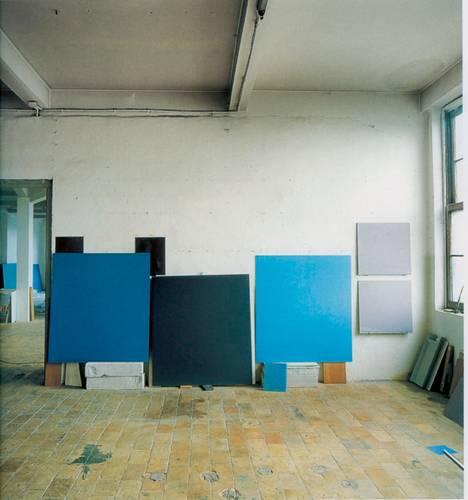MARTHE WÉRY Penser en Peinture
12 Sep - 14 Oct 2006
This exhibition of Marthe Wéry’s work marks the posthumous rediscovery of an extraordinary Belgian painter. Wéry became known for her monochromatic paintings, but her work has remained contemporary thanks to her radical experiments with paint and her exploration of new types of architecturally related installations of her paintings. Painters such as Bernard Frize, Adrian Schiess, or Katharina Grosse further developed her methods of working. As a teacher, she inspired a younger generation of painters, including Ann Veronica Janssen and Joëlle Tuerlinckx.
A palette mutating from black to white and gray characterized Wéry’s early, constructivist paintings: non-colors, therefore, which already conceal within themselves the potential for every color imaginable. In her first monochromatic works, painted in the early 1980s, she began investigating the many facets and rich variety of individual colors. She experimented with format, chassis, and the application of paint, always coaxing new effects from the paint. Using a brush, she painted twenty and sometimes thirty transparent layers of paint on top of each other, while the only hint of them is provided by the slight nuances in color underneath the perfectly smooth, painted surface.
In the 1990s Wéry began experimenting with paint as a material. She dipped the chassis, usually a wooden board or aluminum plate, into large tubs of paint and then left it alone to dry without any interference — or else she worked the paint with broad scrapers during the drying process. The paint formed different skins, some like a transparent veil, some voluminous and opaque. Here, any notion of composition was discarded; the image remains open, eternal, boundless. By limiting the works to monochromatic color, the results are lively and exciting paintings.
Wéry considered her painting a continual, endless process that remained unfinished even after the completion of an individual work. As part of her exploration of architecture and the context of each presentation, she installed her paintings as site-specific ensembles. She employed the given light, composed large tableaux out of different visual formats, occupied the exhibition space in unusual ways, by, for instance, leaning the paintings against the walls or placing them on fragile wooden structures on the floor, as if they were sculptures. It was as if she transposed the situation in the studio to the exhibition site, thereby referring to the radically incomplete character of her painting.?
Marthe Wéry, born in 1930 in Brussels, studied at the Académie de la Grande Chaumière in Paris. Some of her important exhibitions include 1975’s Fundamental Painting at the Stedelijk Museum in Amsterdam, the Venice Biennial in 1982, and a large retrospective at the Palais des Beaux Arts in Brussels in 2001. In 2004 the Musée des Beaux Arts, Tournai (in the art nouveau building by Victor Horta), devoted a large solo show to her work Wéry died in 2005 in Brussels. The Musée des Beaux Arts de Rouen organized the first comprehensive retrospective of her work in 2006.
A palette mutating from black to white and gray characterized Wéry’s early, constructivist paintings: non-colors, therefore, which already conceal within themselves the potential for every color imaginable. In her first monochromatic works, painted in the early 1980s, she began investigating the many facets and rich variety of individual colors. She experimented with format, chassis, and the application of paint, always coaxing new effects from the paint. Using a brush, she painted twenty and sometimes thirty transparent layers of paint on top of each other, while the only hint of them is provided by the slight nuances in color underneath the perfectly smooth, painted surface.
In the 1990s Wéry began experimenting with paint as a material. She dipped the chassis, usually a wooden board or aluminum plate, into large tubs of paint and then left it alone to dry without any interference — or else she worked the paint with broad scrapers during the drying process. The paint formed different skins, some like a transparent veil, some voluminous and opaque. Here, any notion of composition was discarded; the image remains open, eternal, boundless. By limiting the works to monochromatic color, the results are lively and exciting paintings.
Wéry considered her painting a continual, endless process that remained unfinished even after the completion of an individual work. As part of her exploration of architecture and the context of each presentation, she installed her paintings as site-specific ensembles. She employed the given light, composed large tableaux out of different visual formats, occupied the exhibition space in unusual ways, by, for instance, leaning the paintings against the walls or placing them on fragile wooden structures on the floor, as if they were sculptures. It was as if she transposed the situation in the studio to the exhibition site, thereby referring to the radically incomplete character of her painting.?
Marthe Wéry, born in 1930 in Brussels, studied at the Académie de la Grande Chaumière in Paris. Some of her important exhibitions include 1975’s Fundamental Painting at the Stedelijk Museum in Amsterdam, the Venice Biennial in 1982, and a large retrospective at the Palais des Beaux Arts in Brussels in 2001. In 2004 the Musée des Beaux Arts, Tournai (in the art nouveau building by Victor Horta), devoted a large solo show to her work Wéry died in 2005 in Brussels. The Musée des Beaux Arts de Rouen organized the first comprehensive retrospective of her work in 2006.

